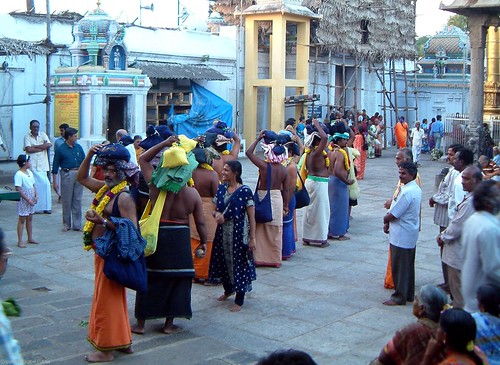
Passing by various temples in Chennai last week, I often saw men dressed in black lungis emerging carrying bundles on their heads. These men are embarking on the Sabarimala pilgrimage to the Ayappa temple in Kerala.
December is the pilgrimage season in South India. The Sabarimala pilgrimage to the Ayappa temple in a hilly region of the state of Kerala bordering Tamil Nadu, is one of the most popular. It receives millions of visitors every year and is reported to be the world’s second largest annual pilgrimage site after the Hajj in Mecca.
The Sabarimala pilgrimage is reserved for men only because women are not allowed to visit the shrine of Ayappa, described as a ‘celibate hermit’. Before starting the journey, pilgrims go through a 41-day ‘austerity’ period during which they must eat only vegetarian food, avoid alcohol and tobacco, abstain from sex, wear a black lungi and beads around the neck, not shave or cut their hair or fingernails, walk barefoot, sleep on the floor without a pillow, and abstain from physical and verbal violence.
Before starting the pilgrimage, the pilgrims seek their blessings from a local temple. Each carries on his head a blanket and a cloth bundle containing traditional offerings like a coconut, ghee (clarified butter) and betel leaves. They make the long journey in groups, travelling in mini-buses. The last four kilometres are made on foot up a steep hill through forests, before reaching the 18 holy steps which lead to the shrine of Lord Ayappa. Here the devotees break a coconut before climbing the holy steps to receive darshan from the god.
A few years ago I took these pictures at the Kapleeswarar temple in Mylapore, Chennai of pilgrims preparing to leave for the Sabarimala pilgrimage.














5 comments :
Pre-pubertal & post-menopausal women do go on pilgrimage, I believe -- the ones who are not tainted by menstrual blood.
Thanks so much to that article link -- I loved it, and it brought back so many memories.
Nancy's comment is true. I met a lady in Kochi. After menopause she has gone, and as an 8 year old girl she went.
Those coconuts might well have ghee poured inside them! I participated in a puja in Kanchipuram some years ago for this pilgrimage. Women came each with their own coconut. Pujari would cut the top, puncture a hole in the top and ghee was carefully poured in by the woman (me included), and pujari would seal it back up. These ghee filled coconuts were taken to Sabraimala, opened, ghee poured over God's murthi, collected back in the coconut and bought back for the women (and families) to eat. Unfortunately, I had to leave India before the ghee returned. My friend said it was tasty.
Yes, Nancy and Jennifer are right: only pre-pubescent girls and post-menopausal women are allowed to undertake the pilgrimage to the temple of Ayappa, who is afterall, a celibate hermit and wants to stay that way. This is one of the reasons given why all other women cannot visit his temple. Others include that women are not capable of doing the 41-day penance or the long trek up to his hilltop temple. Women have tried to challenge this before temple authorities, but to no avail. There's an interesting article on this subject here: http://www.countercurrents.org/gender-raji160704.htm
Isabel,
Thank you for posting that link. It's an amazing site.
I have a few more thoughts. I am an American who was the first to graduate from Madras Christian College. That means I was the only American most of the time. And I follow Hinduism. I came to understand some of these restrictions in a new way. I actually, for instance, won't go to the temple in US if I have my period for a variety of reasons.
I can understand why some women may detest that and other similiar bans (like not being allowed into Ayyappa temple), but there are reasons for these things. The article you posted bring some of these to light- two I agree with most are men are weak and can be tempted by women and they can't break a 41 day celebacy, and the other is entering temple while menustrating. They mention blood with attract animals. I am not so sure that is true because I read an article that animals move further into the forest, avoiding paths humans take into the temple out of fear. I am sure with the large crowds of humans treking through they are afraid they could be killed. Animals are not stupid!
But, the other thing is feminists may try to overturn this ruling, but where are all the articles about festivals where men can't join? Men don't try to encroach on these. Though it may be nicer if everyone could do things together (men and women together) maybe these female-only and male-only festivals also have another purpose, bonding among same-sex friends. In traditional society there may not have been other opportunties for this.
Interesting text; always learning with your posts!
Wish you a very happy, healthy and successful 2008!
Blogtrotter
Post a Comment